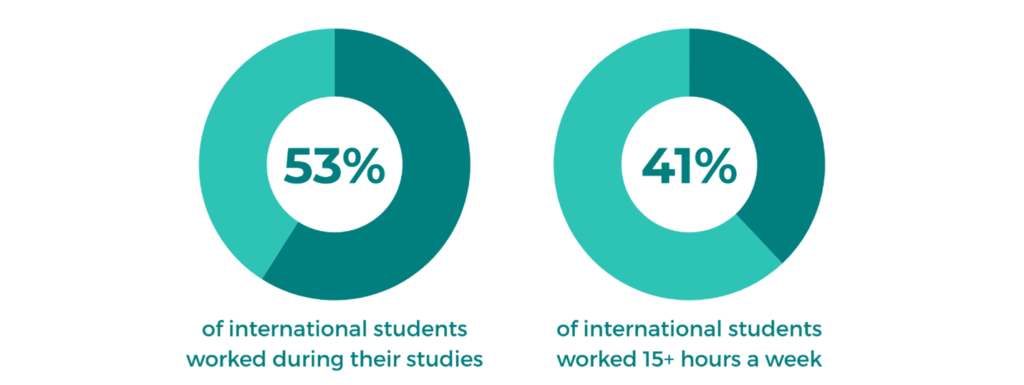By Alana Button and Alexandra MacFarlane
In early 2024, a sweeping federal policy change triggered a dramatic drop in international student enrollment across Ontario. There has been a lot of speculation and concern about how this will impact the country and Ontario specifically. We have already seen budget cuts and layoffs at colleges across the province. And with fewer international students coming to Ontario and reduced part-time working hours for those who do study in Ontario, the province may face a shortage of part-time workers, followed by longer-term effects on the supply of skilled workers. In the local communities in which these students work and study, those impacts could be even more pronounced.
To shed some light on how declining international student numbers may affect the labour market, HEQCO partnered with Fleming College as part of the international education consortium to examine if and where international students are working during their studies. Fleming College administered a 22-question survey to all international students at campuses in Peterborough, Lindsay and Haliburton between fall 2023 and fall 2024, resulting in 1,821 responses. The survey results confirm what many employers already know: prior to the federal policy shift, international students were dedicated workers, working across diverse industries at high rates while studying.
International students work across diverse industries at high rates while studying.
International students at Fleming College arrived highly skilled ─ 56% held undergraduate degrees and 16% had graduate degrees (a master’s degree or PhD). Many international students, no matter their academic background, faced the financial necessity of working while studying.

Fifty-three percent of students surveyed said they were working during their studies — 41% of which said they were working 15 or more hours per week — and 94% of the non-working students said they were looking for work. Like many domestic students, most international students weren’t working in their field of study — they were in entry-level, part-time positions that often pay low wages and require little to no education. Most survey respondents (92%) agreed that their primary reason for working was for a source of income to support themselves. Below, you can see the top five occupations of survey respondents. More than a third worked in food service and retail industries.

Some international students, namely those in programs with direct links to the labour market, secured employment more directly related to their field of study before graduating. Of working respondents, 54% of students studying to be personal support workers and 22% of those in early childhood education were already working in their field — two fields where Ontario is desperate for skilled workers.
At Fleming College, international students helped to power the local workforce, with most working in the communities they called home. Seventy-four percent of international student respondents were working within 40 minutes of where they lived and 79% of respondents were taking public transit, walking or biking to get to work. While these numbers might not be surprising, they highlight the fact that international students were serving, supporting and strengthening the Fleming community.
So, what do fewer international students mean for Ontario’s communities and broader economy? Some employers have already started raising concerns about the decline, describing international students as a vital part of the workforce. However, their absence may not be felt equally across the province. In major cities with large labour pools, the effect may be muted, but in smaller communities, the consequences could be far more pronounced. Fleming College is spread across three campuses outside of the Greater Toronto Area. Smaller college towns, like the ones supported by Fleming College, have come to rely on a constant — and increasing — stream of part-time workers to fill these hourly, shift-based positions. A decline in international student enrollment doesn’t just impact campus life; it means fewer highly educated people available to work in and uplift these local areas.
Smaller college towns have come to rely on a constant stream of part-time workers to fill hourly, shift-based positions.
International students also spend money on rent, public transit and at restaurants, grocery stores and other small businesses. By bringing more spending to the area, Fleming College’s international students have become vital contributors to their local economies. Considering the 14% of survey respondents preferring to work in their campus community after they graduate and the 60% wanting to work in Ontario after they graduate, international graduates who have developed their skills at postsecondary institutions are a large source of skilled labour for the province. Communities across Ontario may feel the loss of this labour pool. Rural and remote areas, where immigrants are crucial in addressing labour shortages and attracting new residents, may especially feel the squeeze.
Communities across Ontario may feel the loss of this labour pool.
Immigration policy changes have impacts on the labour supply and cultural diversity in Ontario’s communities, but they may also lead to longer-term consequences that could weaken the talent pipeline and hinder economic growth for years to come. International students are not just part-time workers; they bring with them diverse ideas, cultures and perspectives, and go on to become talented, skilled graduates with the potential to contribute to Ontario’s economic growth.
For more research on Ontario’s international sector, check out HEQCO’s consortium on international education.
